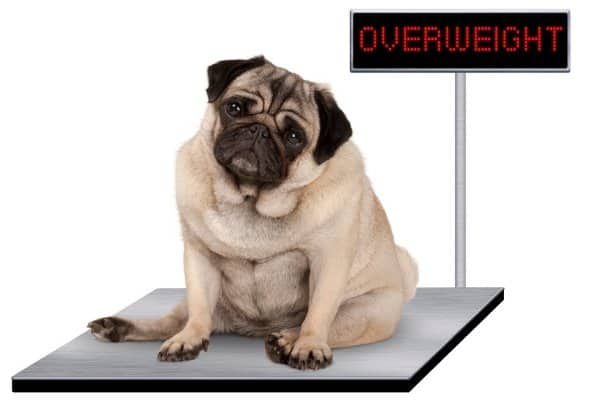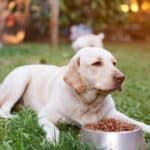Deciding whether or not a dog with a standard body type, like a Labrador Retriever, is of ideal weight is fairly straightforward. Ribs sticking out? The dog is underweight. Rolls of fat visible and ribs can’t be felt? The dog is overweight.
However, barrel-shaped breeds, like Pugs, can be a bit trickier. Pugs are naturally stocky and stout. With broad chests, short legs, and thick midsections, Pugs often appear heavyset even when they are within the normal weight range.
Because of their body type, obesity may not always be obvious. How can you know if your Pug’s weight is normal and healthy?
How much should a pug weigh? The American Kennel Club specifies that Pugs should weigh be between 14 and 18 pounds when fully grown. However, some Pugs are taller or have a larger frame than others and are still at a healthy weight even when exceeding the standard for the breed.
We all want what’s best for our dogs. They depend on us to take good care of them, even when it means showing some tough love.
Let’s look at all the questions and issues surrounding a Pug’s weight so that you can keep your Pug as healthy as possible for as long as possible.
Can a Pug Be Outside the Ideal Weight Range and Still Be Considered Healthy?
Not all Pugs are built the same. Pugs who are taller than normal will, of course, tend to weigh a bit more. The same is true of Pugs with a larger frame. They are naturally bigger which results in a heavier weight.
While the American Kennel Club’s (AKC) breed standard states that Pugs should be between 14 and 18 pounds, a healthy weight for your Pug might be above this range because of the way that he is built.
In fact, many Pugs pass the 18-pound mark before they are finished growing and remain over 18 pounds for the rest of their life. This doesn’t necessarily mean that the Pug is too fat (although it could). It might just be due to his particular build.
Do Male Pugs Weigh More Than Females?
Yes. It is perfectly normal for a male Pug to outweigh a female. Now, we can’t say that this is because female Pugs are usually more dainty and diminutive because no Pug can be described like that.
However, it is extremely common in any dog breed (Pugs included) for the males to be slightly heavier and taller than the females. That’s just the way it is.
Fun Fact: The AKC’s Pug breed standard used to allow for male Pugs to weigh up to 20 pounds.
How to Tell If Your Pug Is Overweight
You know how you don’t really notice how fast your kids are growing or how rapidly an elderly parent is aging until you go for a couple of weeks without seeing them? Then, when you do lay eyes on them, you are blown away by the changes you see.
Subtle changes, like a couple of extra pounds, are hard to spot when you see your Pug day in and day out and can easily go unnoticed until you take the time to properly critique your dog.
Looks can be deceiving, especially when viewed through the eyes of love and not with a critical eye. It’s often helpful to have an unbiased friend with you to provide an honest opinion when you go to evaluate your Pug’s body condition.
Taking your Pug to your veterinarian’s office for a complete health evaluation should be done routinely and your vet can tell you if your Pug is indeed too heavy. However, a quick check for extra body fat can easily be done at home by you.
Visual Evaluation
Take a good, honest look at your Pug.
Are rolls of fat visible on his midsection?
Have his neck and waist seem to have disappeared?
Does he look bloated, almost like he has been stuffed into his skin?
If the answer to any of these evaluation points is yes, then your Pug is too heavy.
Rib Test
Rest your thumbs along your dog’s spine and gently feel for the ribs with your fingertips. They shouldn’t be visible, but you should be able to feel them without pressing too hard.
If they’re buried under a thick layer of fat, you may just barely be able to feel them or you may not find them at all. This is a blaring sign that your Pug is carrying too much body fat.
This video shows a (healthy) Pug going through a bodyweight evaluation.
Mobility Assessment
Spend some time watching your Pug move. Signs of being overweight will be obvious and include:
- Difficulty rising to a standing position.
- Slow, labored gait.
- Struggling to go up or down stairs.
- Lack of motivation to move at all.
- Playtime has become nearly nonexistent.
Signs That Your Pug Is Underweight
Although concerns about Pugs being too skinny aren’t nearly as common as questions about obesity, underweight signs are something you should know how to spot, especially if you’ve been trying to get your Pug to slim down.
You don’t want to go too far with the weight loss plan and wind up with an emaciated dog. Here’s what to look for:
- Ribs are clearly visible.
- The knobby bumps of the spine protrude along the dog’s back.
- Instead of a gradual, slight incline from behind the rib cage toward the hips, there is a sharp rise (while okay in some breeds, this is not normal for Pugs).
- Muscles stand out in sharp contrast, particularly on the rear legs.
Aside from too little food being given, Pugs can become underweight if they are sick or are plagued by intestinal parasites.
A thorough check-up from your veterinarian is called for if you suspect the extra weight loss is due to more than dieting.
Dangers of Pug Obesity
Because Pugs are a brachycephalic breed, breathing issues, overheating, and difficulty when exercising come with the territory. When problems with obesity are added to the mix, brachycephalic symptoms are aggravated and exacerbated.
In addition to the worsening of problems that were there to begin with, being overweight places a great deal of pressure on the heart and circulatory system, the joints, and the spine. This added pressure causes the bones and muscles to become weak, and the dog is at much greater risk for injury.
An overweight Pug is more prone to developing health conditions like diabetes or begin to have issues with kidney and liver function due to the stress that the extra weight places on the body.
The good news is that the leaner and fit your Pug is, the healthier he will tend to be. Let this be your motivation to prevent obesity or actively deal with it if weight is already an issue.
How to Help an Obese Pug Lose Weight
It’s a well-known fact that Pugs like food. Restricting their diet isn’t always easy and surprisingly, may not be the best option.
While cutting out unhealthy treats and table scraps will definitely help, it may not be enough to shed those extra pounds.
If you know that you’ve been overfeeding your dog, then by all means stop. But, if your Pug is eating the recommended amount at each meal and is still struggling with his weight, should you reduce portion sizes?
Not necessarily. Cutting back on portions will leave your Pug feeling hungry and neglected, and he may not receive enough vital nutrients to stay healthy.
A better option is to switch to a dog food made specifically for weight management in small breeds like Purina Weight Management Formula or Hill’s Science Diet Light. This will ensure your dog is still receiving complete nutrition every day while reducing the amount of calorie and fat consumption – a winning recipe for weight loss.
Many veterinarians recommend replacing a portion (up to 10 – 20 %) of the regular kibble with an equal amount of canned green beans. The idea here is that overall calorie consumption is decreased, but the fiber in the green beans gives the dog a sense of fullness.
For occasional variety, apple slices, blueberries, or other healthy, raw fruits and vegetables may be substituted in place of the green beans.
As your Pug’s caloric intake decreases, the amount of time spent exercising should increase. As always, you’ll need to vigilantly watch for any breathing trouble or heat exhaustion, but don’t let this deter you from increasing your Pug’s physical activity.
Gradual is key. The first week of implementing the increased exercise just add 5 minutes to every walk or play session. The next week, increase the time by 5 minutes again. Continue in this way until you begin to see results.
Remember to maintain these new exercise times even after your Pug is back to an acceptable weight to prevent a recurrence of the problem.
Need More Help?
If you still find yourself with questions about your Pug’s weight, check with your veterinarian. Be sure to schedule regular visits so they can monitor your pup’s weight and overall health.


![How Much Should a Shih Tzu Weigh? [Both Puppies & Adults] (2024) A cute brown-and-white Shih Tzu with a long coat, blue bow in her hair, and tongue panting.](https://www.trendingbreeds.com/wp-content/uploads/2021/12/White-and-brown-Shih-Tzu-with-blue-bow-150x150.jpg)


